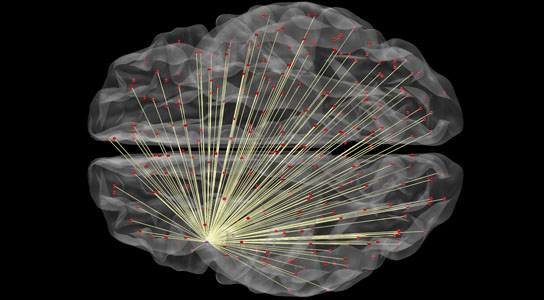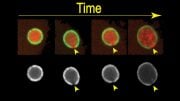
New research suggests as much as 10 percent of individual variances in human intelligence can be predicted based on the strength of neural connections between the lateral prefrontal cortex and other regions of the brain. Credit: WUSTL Image / Michael Cole
A newly published study from neuroscientists at Washington University in St. Louis provides evidence that neural connections between the lateral prefrontal cortex and the rest of the brain make a unique and powerful contribution to the cognitive processing underlying human intelligence.
When it comes to intelligence, what factors distinguish the brains of exceptionally smart humans from those of average humans?
As science has long suspected, overall brain size matters somewhat, accounting for about 6.7 percent of individual variation in intelligence. More recent research has pinpointed the brain’s lateral prefrontal cortex, a region just behind the temple, as a critical hub for high-level mental processing, with activity levels there predicting another 5 percent of variation in individual intelligence.
Now, new research from Washington University in St. Louis suggests that another 10 percent of individual differences in intelligence can be explained by the strength of neural pathways connecting the left lateral prefrontal cortex to the rest of the brain.
Published in the Journal of Neuroscience, the findings establish “global brain connectivity” as a new approach to understanding human intelligence.
“Our research shows that connectivity with a particular part of the prefrontal cortex can predict how intelligent someone is,” suggests lead author Michael W. Cole, PhD, a postdoctoral research fellow in cognitive neuroscience at Washington University.
The study is the first to provide compelling evidence that neural connections between the lateral prefrontal cortex and the rest of the brain make a unique and powerful contribution to the cognitive processing underlying human intelligence, says Cole, whose research focuses on discovering the cognitive and neural mechanisms that make human behavior uniquely flexible and intelligent.
“This study suggests that part of what it means to be intelligent is having a lateral prefrontal cortex that does its job well; and part of what that means is that it can effectively communicate with the rest of the brain,” says study co-author Todd Braver, PhD, professor of psychology in Arts & Sciences and of neuroscience and radiology in the School of Medicine. Braver is a co-director of the Cognitive Control and Psychopathology Lab at Washington University, in which the research was conducted.
One possible explanation of the findings, the research team suggests, is that the lateral prefrontal region is a “flexible hub” that uses its extensive brain-wide connectivity to monitor and influence other brain regions in a goal-directed manner.
“There is evidence that the lateral prefrontal cortex is the brain region that ‘remembers’ (maintains) the goals and instructions that help you keep doing what is needed when you’re working on a task,” Cole says. “So it makes sense that having this region communicating effectively with other regions (the ‘perceivers’ and ‘doers’ of the brain) would help you to accomplish tasks intelligently.”
While other regions of the brain make their own special contribution to cognitive processing, it is the lateral prefrontal cortex that helps coordinate these processes and maintain focus on the task at hand, in much the same way that the conductor of a symphony monitors and tweaks the real-time performance of an orchestra.
“We’re suggesting that the lateral prefrontal cortex functions like a feedback control system that is used often in engineering, that it helps implement cognitive control (which supports fluid intelligence), and that it doesn’t do this alone,” Cole says.
The findings are based on an analysis of functional magnetic resonance brain images captured as study participants rested passively and also when they were engaged in a series of mentally challenging tasks associated with fluid intelligence, such as indicating whether a currently displayed image was the same as one displayed three images ago.
Previous findings relating lateral prefrontal cortex activity to challenging task performance were supported. Connectivity was then assessed while participants rested, and their performance on additional tests of fluid intelligence and cognitive control collected outside the brain scanner was associated with the estimated connectivity.
Results indicate that levels of global brain connectivity with a part of the left lateral prefrontal cortex serve as a strong predictor of both fluid intelligence and cognitive control abilities.
Although much remains to be learned about how these neural connections contribute to fluid intelligence, new models of brain function suggested by this research could have important implications for the future understanding — and perhaps augmentation — of human intelligence.
The findings also may offer new avenues for understanding how breakdowns in global brain connectivity contribute to the profound cognitive control deficits seen in schizophrenia and other mental illnesses, Cole suggests.
Reference: “Global Connectivity of Prefrontal Cortex Predicts Cognitive Control and Intelligence” by Michael W. Cole, Tal Yarkoni, Grega Repovš, Alan Anticevic and Todd S. Braver, 27 June 2012, Journal of Neuroscience.
DOI: 10.1523/JNEUROSCI.0536-12.2012
Other co-authors include Tal Yarkoni, PhD, a postdoctoral fellow in the Department of Psychology and Neuroscience at the University of Colorado at Boulder; Grega Repovs, PhD, professor of psychology at the University of Ljubljana, Slovenia; and Alan Anticevic, an associate research scientist in psychiatry at Yale University School of Medicine.
Funding from the National Institute of Mental Health supported the study (National Institutes of Health grants MH66088, NR012081, MH66078, MH66078-06A1W1, and 1K99MH096801).









Pedeomorphosis and pareomorphosis are two things related to the connectivity of the brain`s left cognitive lobe and right lobe. The connectivity goes on in all human beings till the age of 21 or even more whereas in animals they are only for short period. Even a big elephant`s mental age is only 5 years of a human baby, even if its physical age is about 50 or more. So elephant will never take vengeance or even worse is assuming a snake`s vengeance behaviour, because its mental age will be only a few months of human growth. All animals are extremely good in character and they hunt only for their food and never broach any enmity amongst themselves. The article`s research clearly shows enormous connection between the two lobes of human brain, which actually is a measure of not only the intelligence but also happens to cause the vileful character of humans growing, to boss everything in the world. Thank You.
There are several apolitical sociological surveys as part of a behavioral science study that actually concur what (Dr.?) Madanagopal is pointing out. It’s interesting to me, in that I wonder if there is any research regarding the merging of neanderthal with cro magnon, as being the fundamental reason why no matter where you go, no matter what government is in place, no matter how many parties come into play, the most significant division among any citizenry comes down to righteous and leftist ideologies. The centrics would be a very interesting part of such a study, because I’d bet they have this enhanced interlobe connectivity. I will probably get flamed for even suggesting this — Though it probably qualifies as racist, that is not my intention — it is also interesting to see that because there are no two distinct races of neanderthal and cro magnon, somehow it probably avoids the immediate stigma… It’s probably why nobody has this data. What would be the positive use of such data? None. ALl negative. Too bad for science.